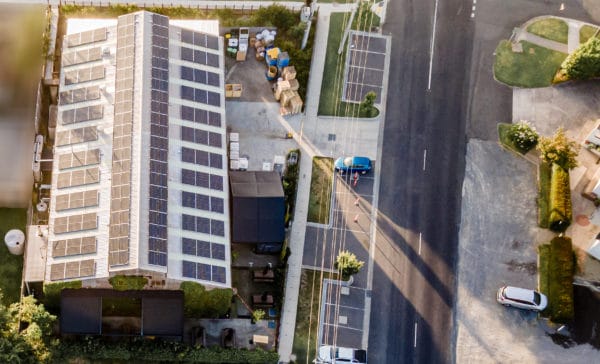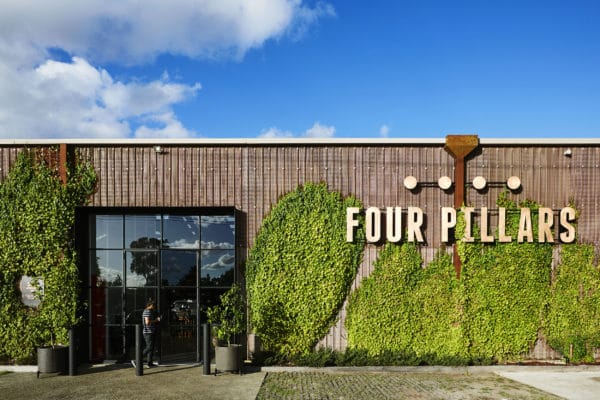A few powerful reasons lay behind Australian distillery Four Pillars’ decision to install 65.88 kW of solar on the roof at its Healesville Victoria headquarters. Among them, its eligibility for low-cost finance from the Sustainable Australia Fund (SAF), which also allows the business to repay the capital cost of the system as part of its council rates over time — in this case over 10 years — and so quickly realise savings on its electricity outlay.
“With terms of up to 20 years and low interest rates, the repayments are so low that the business is often making money from upgrades from the very first year,” says Scott Bocskay, CEO of SAF.
Four Pillars has become a destination, a household name and internationally recognised for excellence, since three partners launched the boutique distillery with one copper still, named Wilma after co-founder Cameron McKenzie’s late mother, in 2013.
In recent times, McKenzie says when Four Pillars was heating the expanded business’s production stills — which now include Jude, Eileen, Beth and Coral — “no-one in the street” could “cook a piece of toast”.
The partners’ decision to go solar has significantly reduced the burden on the grid around Healesville, and over the 10 years of the finance agreement will reduce carbon emissions by some 1,600 tCO2-e — which is the equivalent of powering 185 homes for a year.

Image: Four Pillars
The black cherry on the solar cake
The solar installation was carried out by Cherry Energy Solutions, part of the Echo Group acquired last year by Hong Kong-owned EnergyAustralia, and went so far as to use black-framed panels to match the style of the boutique distillery building. Cherry Energy Solutions is one of the trusted local installer partners selected by SAF to meet its high required standards of system design and workmanship.
Expected to save Four Pillars $12,800 in energy bills each year, the solar system was financed through an Environmental Upgrade Agreement, via SAF, which evolved out of the Sustainable Melbourne Fund in 2019 when it negotiated a $200 million line of finance from the Victorian-based, customer-owned Bank Australia.

Image: Four Pillars
Council elders with a sustainable vision
The City of Melbourne is legendary for its foresight in having established a unique new form of financing — no upfront cost, low interest, long payback period — in 2002 that would increase the sustainability of the city’s buildings. It was intended to “overcome many of the barriers to environmental upgrades, including business cashflow and the split incentive between landlords and tenants”, explains the SAF website.
In 2020 the Australian Renewable Energy Agency (ARENA) further boosted SAF’s funding pool by $630,000, to extend the number of councils eligible to participate into South Australia and New South Wales, and also to support the development of an online platform that would make Environmental Upgrade Finance easier to implement. More than 40 councils around Australia are now partnered with the SAF program.
Ease of administration
From Four Pillars’ perspective, the process of applying for and deploying the loan facility has been “easy, transparent and rewarding”, says McKenzie.
“Like all growing businesses,” he adds, “we have various loans and finance arrangements for building works and equipment. This was the easiest and fastest project we’ve ever worked on.”
The distillery’s agreement is with SAF, and Yarra Ranges Council which administers the repayments. McKenzie says the business barely notices these outgoings, “as they come through on our rates notice”.
Four Pillars is the seventh Environmental Upgrade Agreement provided within the area of Yarra Ranges Council, which has been particularly active in helping businesses unlock the savings enabled by this form of funding, while also reducing the region’s carbon emissions.
Aurrum Aged Care, in Healesville, for example, used Environmental Upgrade financing to install a 96 kW, 300-panel rooftop solar system, and found that during hot summer days at times of peak power consumption the facility could renewably produce 85% of its electricity needs.
“It’s an absolute win-win for the businesses that have jumped on board, says local mayor Fiona McAllister.
A waste-reducing, energy-efficiency drive
Aside from solar installations, other examples of projects that may qualify for Environmental Upgrade Finance include energy-efficient lighting, heating, ventilation and air-conditioning, as well as projects that minimise water use and waste — the finance is only available for upgrades to non-residential buildings.
In an example of how businesses can deploy the funds saved by non-upfront payment for environmental upgrades, Four Pillars is planning a $6 million expansion of its facility, to be designed by sustainability specialists, Breathe Architecture, which will incorporate more solar as well as waste reduction initiatives.
“If there’s an option anywhere in the business to be more sustainable, we’ll always try,” says McKenzie, who adds,“Environmentally, it’s 100% the right thing to do, and we get great feedback from customers who walk through the door.”
This content is protected by copyright and may not be reused. If you want to cooperate with us and would like to reuse some of our content, please contact: editors@pv-magazine.com.









By submitting this form you agree to pv magazine using your data for the purposes of publishing your comment.
Your personal data will only be disclosed or otherwise transmitted to third parties for the purposes of spam filtering or if this is necessary for technical maintenance of the website. Any other transfer to third parties will not take place unless this is justified on the basis of applicable data protection regulations or if pv magazine is legally obliged to do so.
You may revoke this consent at any time with effect for the future, in which case your personal data will be deleted immediately. Otherwise, your data will be deleted if pv magazine has processed your request or the purpose of data storage is fulfilled.
Further information on data privacy can be found in our Data Protection Policy.